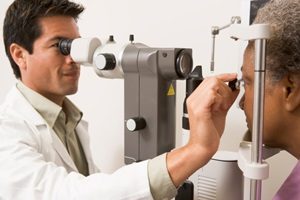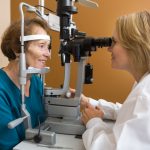 Glaucoma is a serious eye disease and one of the leading causes of blindness. It damages the eye’s optic nerve when the fluid pressure inside the eyes slowly rises. It’s all too common. According to the Glaucoma Research Foundation, estimates suggest more than three million Americans have glaucoma but only half of those know they have it.
Glaucoma is a serious eye disease and one of the leading causes of blindness. It damages the eye’s optic nerve when the fluid pressure inside the eyes slowly rises. It’s all too common. According to the Glaucoma Research Foundation, estimates suggest more than three million Americans have glaucoma but only half of those know they have it.
That’s because the signs and symptoms of glaucoma, and understanding what is glaucoma, just aren’t on the radar. They should be.
Advertisement
Glaucoma is an eye disease that gradually steals sight without warning. Which makes a regular comprehensive eye exam so important.
African Americans have glaucoma at a rate three times that of whites. And they experience blindness four times more frequently. Between the ages of 45 and 64, glaucoma is 15 times more likely to cause blindness in African Americans than in whites.
Other high-risk groups include people over 60, family members of people with glaucoma, diabetics, and people who are severely nearsighted.
Signs and symptoms of glaucoma
 When it comes to the signs and symptoms of glaucoma, it’s a tricky disease to track. The most common type of glaucoma, primary open-angle glaucoma, has virtually no signs or symptoms –except gradual vision loss. The problem is, if left untreated, glaucoma can lead to blindness and any vision loss can’t be restored.
When it comes to the signs and symptoms of glaucoma, it’s a tricky disease to track. The most common type of glaucoma, primary open-angle glaucoma, has virtually no signs or symptoms –except gradual vision loss. The problem is, if left untreated, glaucoma can lead to blindness and any vision loss can’t be restored.
There is no cure. Treatment usually includes a lifetime of prescription eye drops, and surgery in some cases. The point to remember is that early diagnosis and treatment can control glaucoma before vision loss or blindness occurs. Annual eye exams are a must to monitor any changes in your vision and detect early glaucoma.
New research is looking at lowering pressure inside the eye, and developing medications to protect and preserve the optic nerve from the damage that causes vision loss, says the NIH. There also has been progress in identifying the genetics of glaucoma in the last few years, including the discovery of genes found to be associated with many forms of glaucoma.
We’ve mentioned the lack of signs and symptoms of glaucoma in its most common form. But the less common kind, acute-angle closure glaucoma, is an emergency. It requires immediate treatment to reduce eye pressure as quickly as possible. If you experience any of the following, seek immediate medical attention:
- Severe eye pain
- Nausea or vomiting
- Redness in the eye
- Sudden vision disturbances
- Seeing colored rings around lights
- Blurred vision.
Causes of glaucoma
What causes glaucoma and puts everyone at risk? Let’s turn to the inner workings of the eye. The back of the eye is continuously producing a clear fluid known as aqueous humor. This fluid fills the front part of the eye and then exits through channels in the cornea and iris. But if these channels are obstructed in any way, the natural eye pressure (called intraocular pressure or IOP) in your eye may increase.
That means trouble: The optic nerve may become damaged and you may start losing sight in your eye.
People with diabetes and those with high blood pressure and heart disease have an increased risk of developing glaucoma. Chronic eye inflammation and thin corneas can lead to increased pressure in your eyes. Physical injury or trauma to the eye, such as being hit in the eye, can also cause eye pressure to increase.
Still, causes of glaucoma aren’t exactly known. What makes the IOP increase? Possible links include the following:
- Poor or reduced blood flow to the optic nerve
- High or elevated blood pressure
- Dilating eye drops
- Blocked or restricted drainage in the eye
- Medications, such as corticosteroids.
Types of glaucoma
 There are different types of glaucoma of which to be aware. As we’ve mentioned, chronic open-angle glaucoma and acute-angle closure glaucoma are the two most often diagnosed. The Glaucoma Research Foundation lists these two, along with two other types you may come across.
There are different types of glaucoma of which to be aware. As we’ve mentioned, chronic open-angle glaucoma and acute-angle closure glaucoma are the two most often diagnosed. The Glaucoma Research Foundation lists these two, along with two other types you may come across.
Open-angle glaucoma, the most common form of glaucoma, accounts for at least 90 percent of all glaucoma cases. This chronic disease has no signs or symptoms except gradual vision loss, often so slow that your vision will have incurred irreparable damage before any other signs become apparent.
“Open-angle” indicates that the angle where the iris meets the cornea is as wide and open as it should be.
Acute-angle closure glaucoma is the result of the angle between the iris and cornea closing. Symptoms are acute and immediate medical attention is necessary.
Other variations of open-angle and acute-angle closure glaucoma include:
- Secondary glaucoma
- Pigmentary glaucoma
- Pseudoexfoliative glaucoma
- Traumatic glaucoma
- Neovascular glaucoma
- Irido corneal endothelial syndrome (ICE)
The other two types to note are as follows:
Normal-tension glaucoma (NTG), also termed low-tension or normal-pressure glaucoma, occurs when the optic nerve is damaged even though the eye pressure is not very high. Doctors don’t know why some people’s optic nerves are damaged even though they have almost normal pressure levels.
Congenital glaucoma happens in babies when there is incorrect or incomplete development of the eye’s drainage canals during the prenatal period. This is a rare condition which may be inherited. Surgery can often correct the structural defects while other cases are treated with medication and surgery.
What is glaucoma?
Understanding glaucoma and the signs and symptoms of glaucoma are part of public awareness that needs to happen. A survey done for the Glaucoma Research Foundation found that:
74 percent of over 1,000 people interviewed said they have their eyes examined at least every two years. That’s good, but we need to get those numbers up.
61 percent of those (less than half of all adult Americans) are receiving a dilated eye exam (the best and most effective way to detect glaucoma).
16 percent of African Americans were unfamiliar with glaucoma.
9 percent of Caucasians were unfamiliar with glaucoma.
Let’s spread the word and protect our vision with awareness of what causes glaucoma – and dilated eye exams, at least every two years.
Related Reading:
Debunked: 7 eyesight myths you need to stop believing
Advertisement
When it comes to keeping ourselves in good health, we’re given a lot of advice. Depending on where you get the advice from, a lot of it can be false. It can make it hard to tell fact from fiction because we start to believe it, the more we hear it. But the truth of the matter is…
Are these daily habits damaging your eyes?
Despite how important our eyesight is, we tend to take it for granted. There are certain habits, in particular, that we continue to put our eyes through that are actually quite damaging. If any of the following sound familiar, now’s the time to stop.

